Chicken Manchurian (Crispy with Gravy)
Chicken Manchurian is so popular that it’s somewhat synonymous with Indo-Chinese cuisine. Crispy chicken enveloped in a spicy, tangy, sweet sauce…everything we love! This quick & easy recipe makes truly crispy chicken with an ample amount of sauce. Tested to perfection!
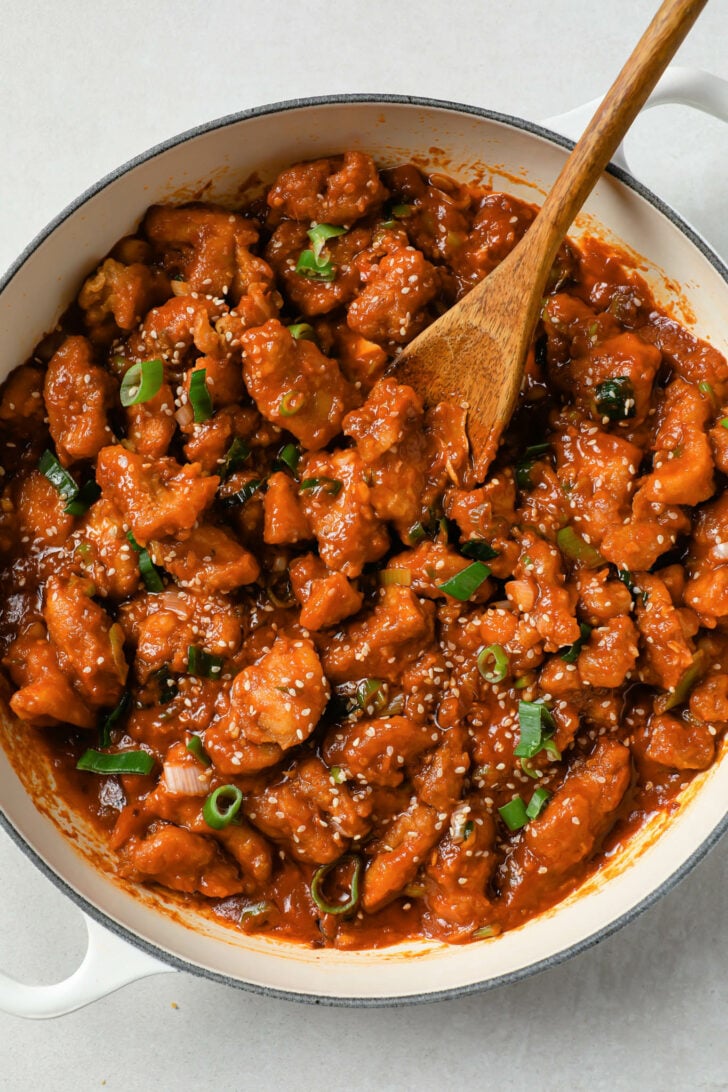
Want to save this post?
Enter your email below and get it sent straight to your inbox. Plus, get recipes & tips every week!
It’s true that recipes on Tea for Turmeric come to you after some pretty rigorous R&D. See Mango Lassi, which had me standing in line at half a dozen restaurants. Or Chicken Biryani, which I tested so often that I can’t make it anymore. And let’s not forget Dahi Bhallay, which, to our delight and concern, overshadowed the Iftar table almost every evening last Ramadan.
But this Chicken Manchurian recipe has seen a particularly intense development phase. To come up it, I…
- Tasted it at several restaurants, including Yum & Mei Kong in Lahore and Aga’s here in Houston.
- Took a Chinese cooking class….in Pakistan.
- Studied the principles of stir-fry from Kenji’s book The Wok.
- Tested it so many times that I’m practically Manchurian. (JK! As you’ll read below, Chicken Manchurian has little to do with China.)
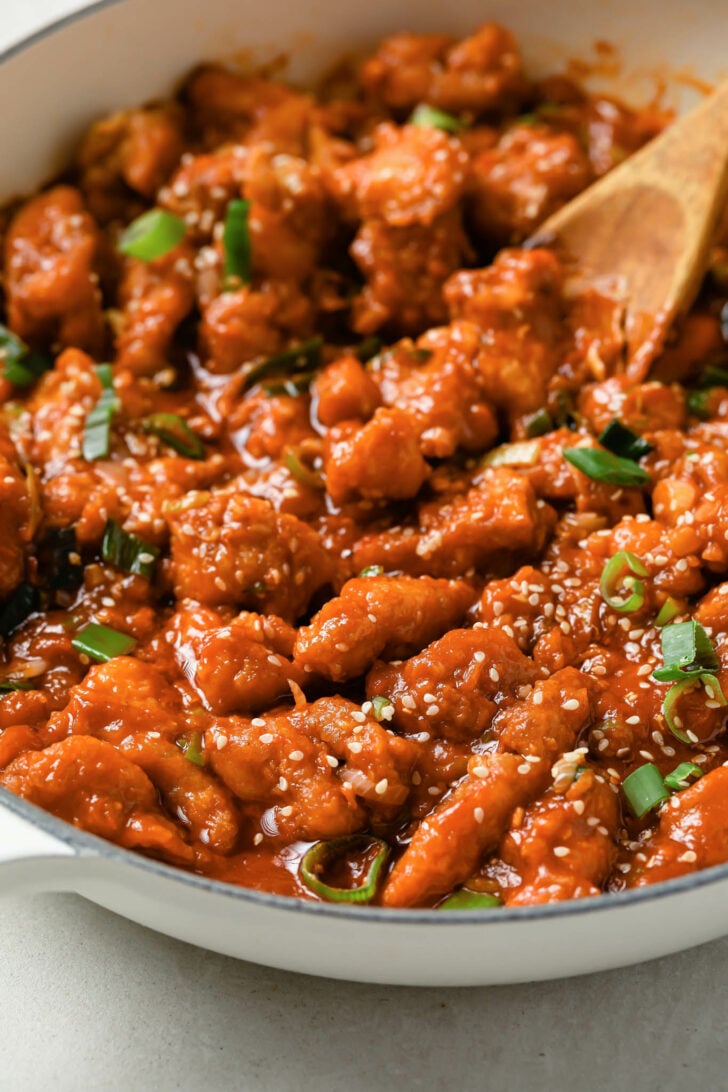
What is Chicken Manchurian?
Chicken Manchurian is an Indo-Chinese dish with fried chicken in a hot and sweet dark-red sauce. It’s an entirely restaurant born and propagated dish, and it has all sorts of variations such as Gobi Manchurian, Paneer Manchurian, a dry version, a saucy version, and so on.
Despite its name, Chicken Manchurian is not Chinese, nor does it come from what was historically known as Manchuria, China. Chicken Manchurian was actually invented by Nelson Wang, an Indian restaurateur of Chinese origin. As Wang himself noted, “What is Manchurian? Nothing! I made it up. There is not even a proper cuisine called Manchurian.”
As a third-generation immigrant in India, Wang knew little about the up-and-coming Sichuan cuisine in the 1970s. But he did have a knack for adapting Asian cuisine to Indian preferences – mainly by deep-frying everything and adding heat to the sauces. Fair enough.
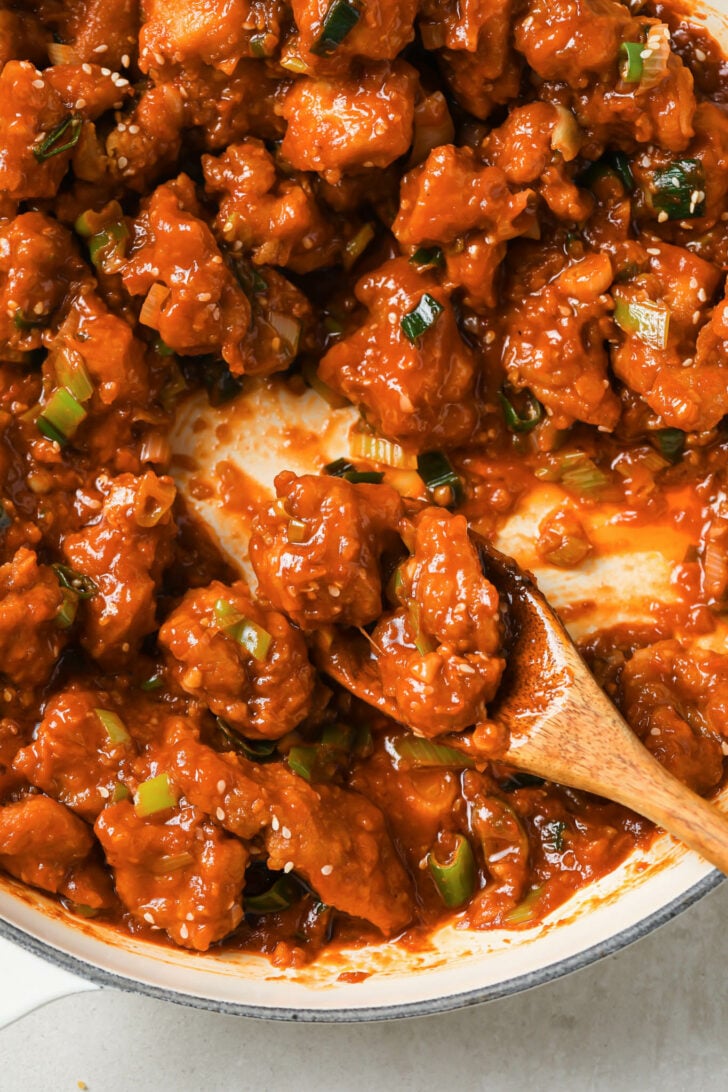
Pakistani-Style Chicken Manchurian vs Indo-Chinese Restaurant Style
Having traveled to Pakistan recently, I noticed a clear difference between the Chicken Manchurian there vs here in the U.S.
- Pakistani-style Manchurian is wading in red sauce, and the chicken is only slightly crispy with a cornstarch-only batter.
- Indo-Pak restaurant Manchurian is almost always crispy (flour is involved) and only lightly coated in sauce. Like Chicken Shashlik and Chicken Jalfrezi, Manchurian here is often accompanied with cubed red and green bell peppers and onions.
This recipe is an amalgamation of both styles – it’s crispy AND saucy. If you’d rather not deep fry or would prefer a less-crispy, more Pakistani-style version, I’ve shared instructions on how to make the pan-fried version in the Variations section.
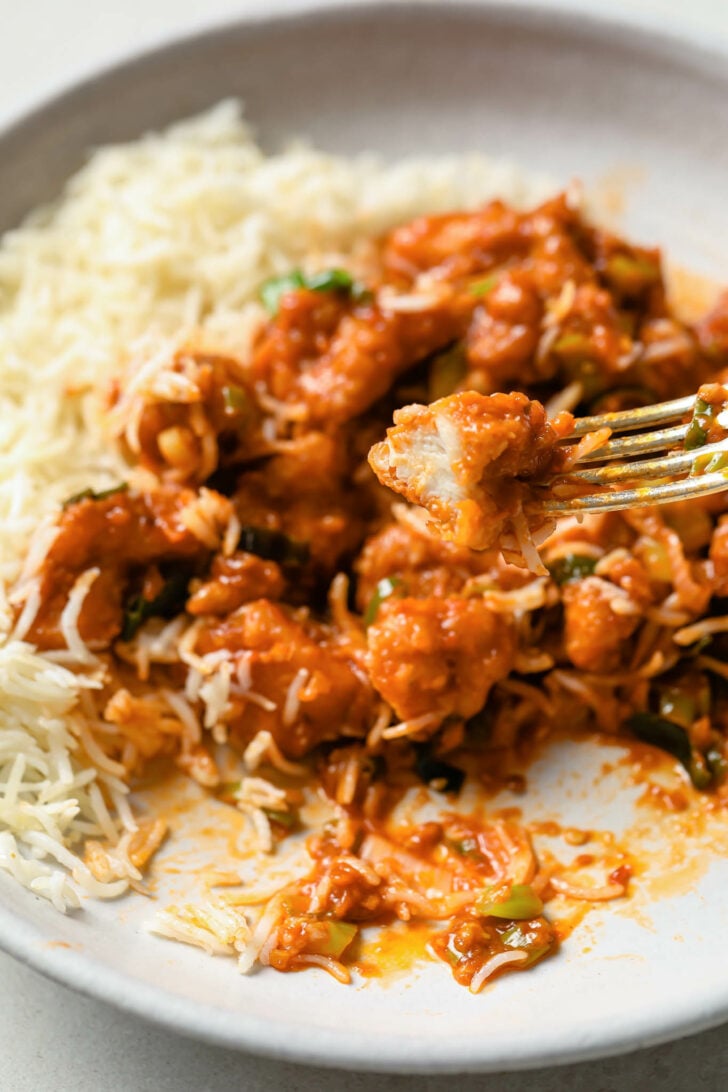
Ingredients for Chicken Manchurian
This recipe has 3 components:
- Chicken (Marinade + Crispy Coating): The chicken gets coated first in an egg mixture, then in a dry coating before being fried.
- Sauce: This is the sauce or gravy that coats the chicken. I love the sauce to chicken ratio of this recipe but I’ve given tips on how to make it even more saucy in the Variations.
- Stir-fry: Though this isn’t a traditional stir-fry, you do lightly brown the garlic, ginger, and green onion before adding the sauce and chicken back in.
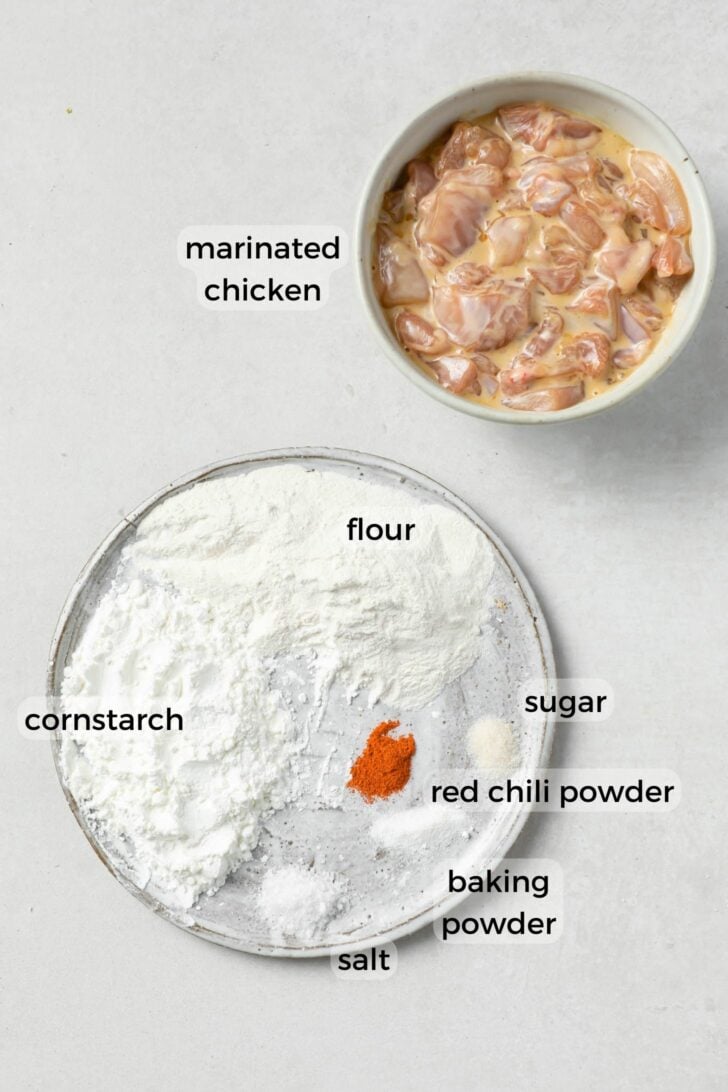
Marinade Ingredients
My marinade is adapted from Kenji’s latest book, The Wok. To develop his chicken coating recipe, he tried out several batters to see which would result in the crispiest chicken.
- Chicken: I prefer chicken thighs because they can withstand overcooking and still remain juicy and tender. But chicken breast will also work well.
- Egg white: Kenji noted that thicker, egg-based marinades provided superior results to thinner ones without egg.
- Soy sauce: You can use gluten-free soy sauce, tamari, and probably even coconut aminos.
- Rice vinegar or white vinegar: Kenji uses wine for the acidic element, which I’ve replaced with vinegar for obvious reasons. I prefer using rice vinegar for Asian dishes for the flavor and because it’s a little less intense. But in this quantity, you can hardly tell the difference.
Dry Coating:
- Cornstarch: Called cornflour in other parts of the world, this adheres to the chicken and makes it crispy.
- All-purpose flour: Unlike cornstarch-only recipes like Cashew Chicken, Chicken Manchurian is tossed in flour to make it extra crispy. I haven’t tried using gluten-free flour in this particular recipe, but I have in past versions and I suppose it would work here as well.
- Red chili powder or cayenne: To add heat to the chicken itself. The chicken alone isn’t too spicy. The sauce takes care of that. But you can always add more spice here too if you like.
Manchurian Sauce Ingredients
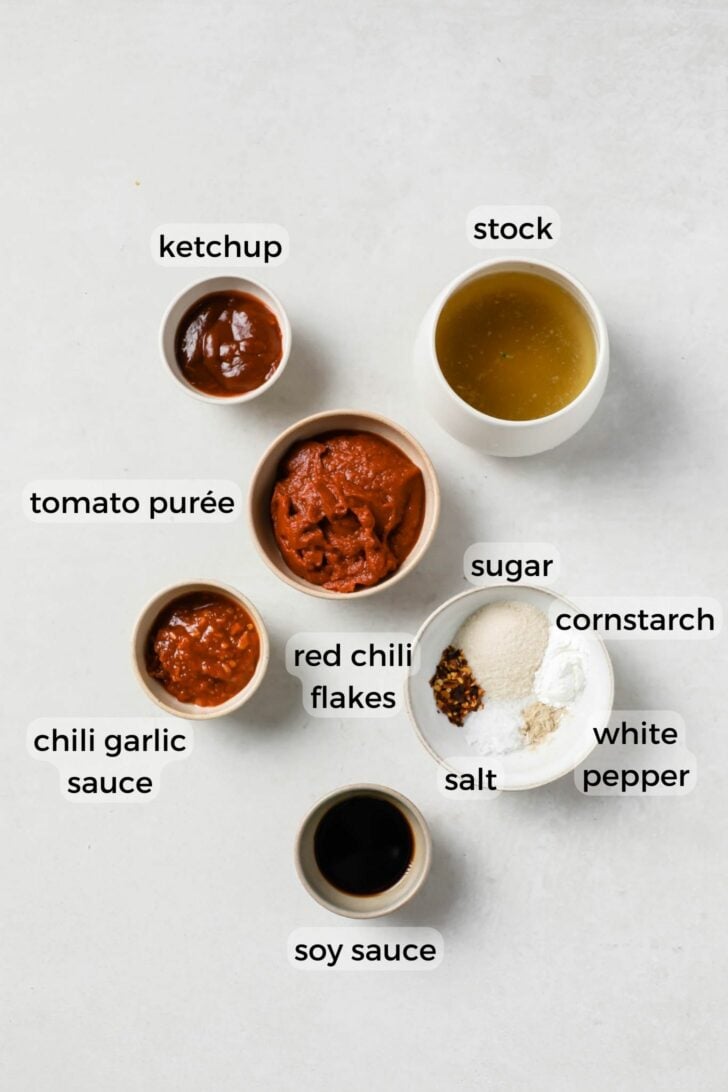
- Vegetable or Chicken Stock: The first ingredient used to make it extra saucy and to add depth of flavor. I use store-bought vegetable stock, but chicken stock can’t hurt.
- Tomato purée or tomato sauce: The second ingredient that adds sauce without making it overtly ketchupy. This is the runny kind that comes in a can or jar, but isn’t thick like tomato paste.
- Ketchup: I use Hunt’s Natural or Heinz Organic. (Other awesome recipes that use ketchup: Stovetop Chicken Thighs and Chicken Shashlik.)
- Chili garlic sauce: Adds heat, tang, and subtle sweet complexity, basically all the flavors we want in Manchurian. To lean more into South Asian flavors, I’ve tested with South Asian brands such as Mitchell’s or Maggi Hot & Sweet. But feel free to use Huy Fong Chili Garlic Sauce, Sriracha, or your favorite chili sauce (start with 1 tbsp so that it doesn’t get too spicy). Because of the tang this sauce adds, I find adding vinegar in the sauce unnecessary.
- Sugar: I use raw cane but white or turbinado sugar work. Naturally, the other sauces you use may vary the amount you need, specifically the chili garlic sauce. Whether you use tomato purée (which doesn’t contain added sugar) or tomato sauce (which sometimes does) may also cause a slight variation.
- Red chili flakes: Add extra heat and compensate if your chili garlic sauce isn’t the spicy kind.
- White pepper or black pepper: I prefer using white pepper for Asian dishes, but black pepper will work equally well.
- Cornstarch: To thicken the batter. Most chinese recipes will have you make a separate cornstarch slurry, which allows you to cook the sauce before thickening it. I skip making a separate cornstarch slurry because you’re only simmering the sauce for a couple minutes (and because I’ll cut steps wherever I can).
Stir-Fry Ingredients
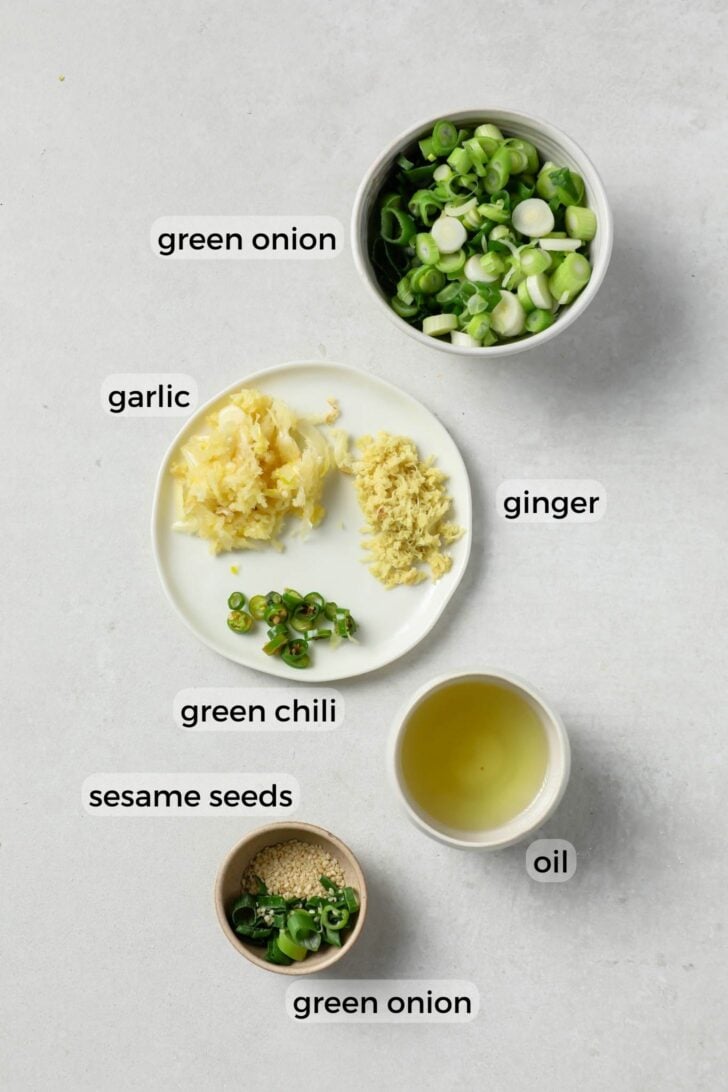
- Garlic & ginger: Usually, I either run these through a food processor or use a mortar & pestle to crush them. In this case, you want to use a knife or food processor to finely chop so the garlic doesn’t become mushy and the ginger doesn’t become stringy.
- Green onions: Also called scallions, and sometimes spring onions. I like to chop the white and light green parts very finely. Sometimes I’ll just throw them in the food processor with the garlic and ginger. Slice the deep green parts and keep for garnish.
How to make Chicken Manchurian
Here’s what you’ll do:
- Marinate the chicken: First, toss the chicken with the egg white marinade.
- Prepare dry coating: Next, combine the dry coating ingredients and set aside for when you’re ready to fry the chicken.
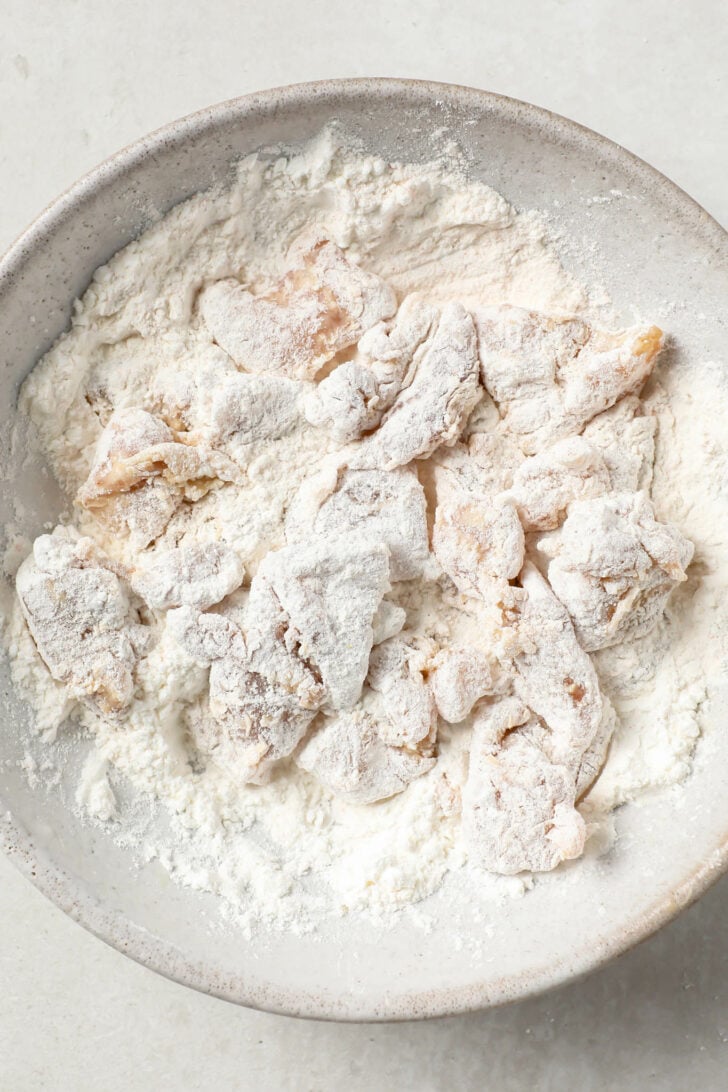
- Make the sauce: Mix the ingredients for the sauce and set aside.
- Coat chicken & shake off excess: Add half the chicken at a time to the dry coating, tossing to coat each piece. Some recipes will have you coat the chicken one piece at a time but my patience runs out in such situations. Other recipes use a colander to shake off the excess flour. The goal is to coat each piece fully so that the flour adheres and the chicken pieces don’t end up clumping up. You also want to avoid adding excess flour in the oil, which can lead to murky oil and burning.
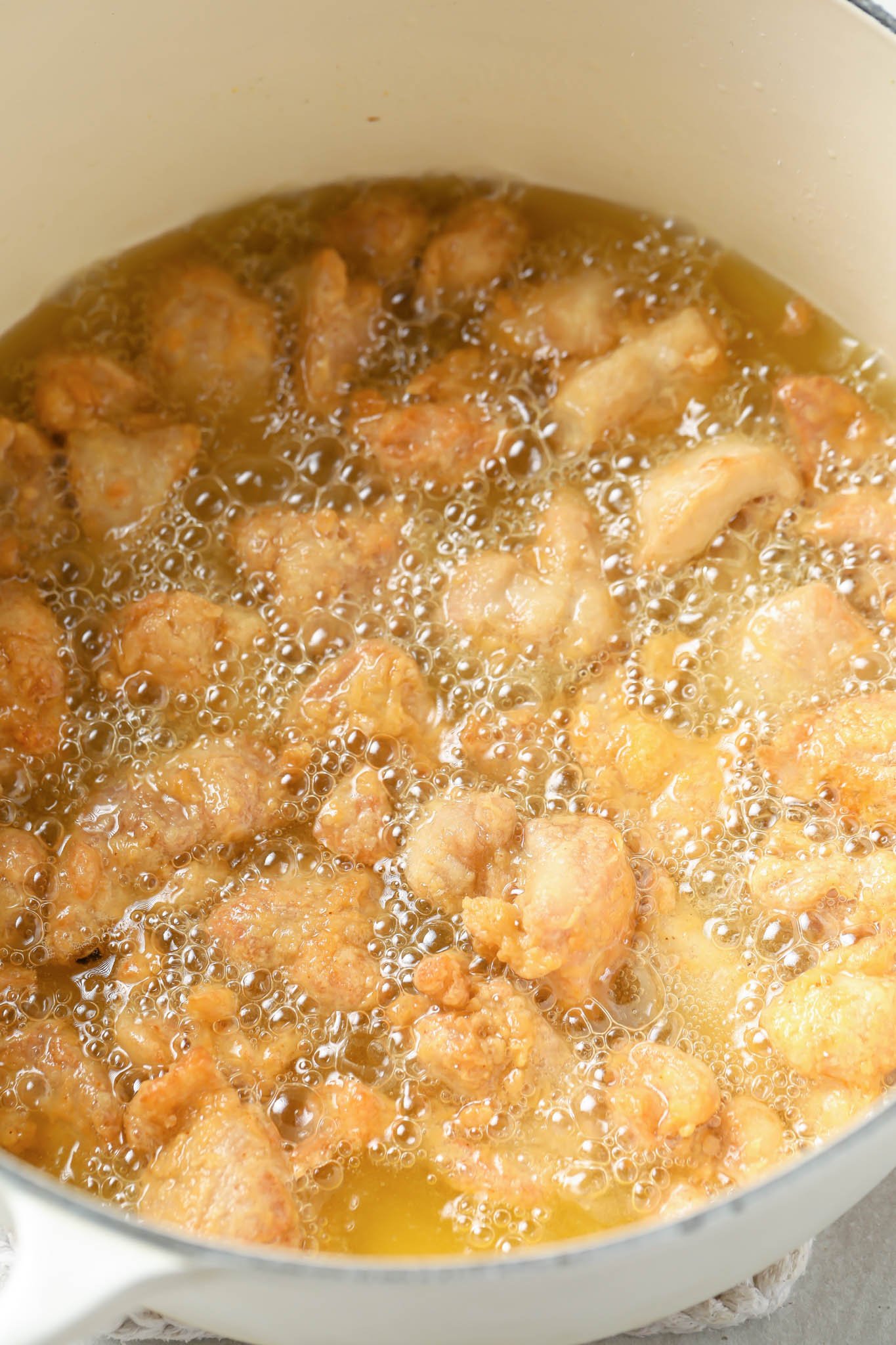
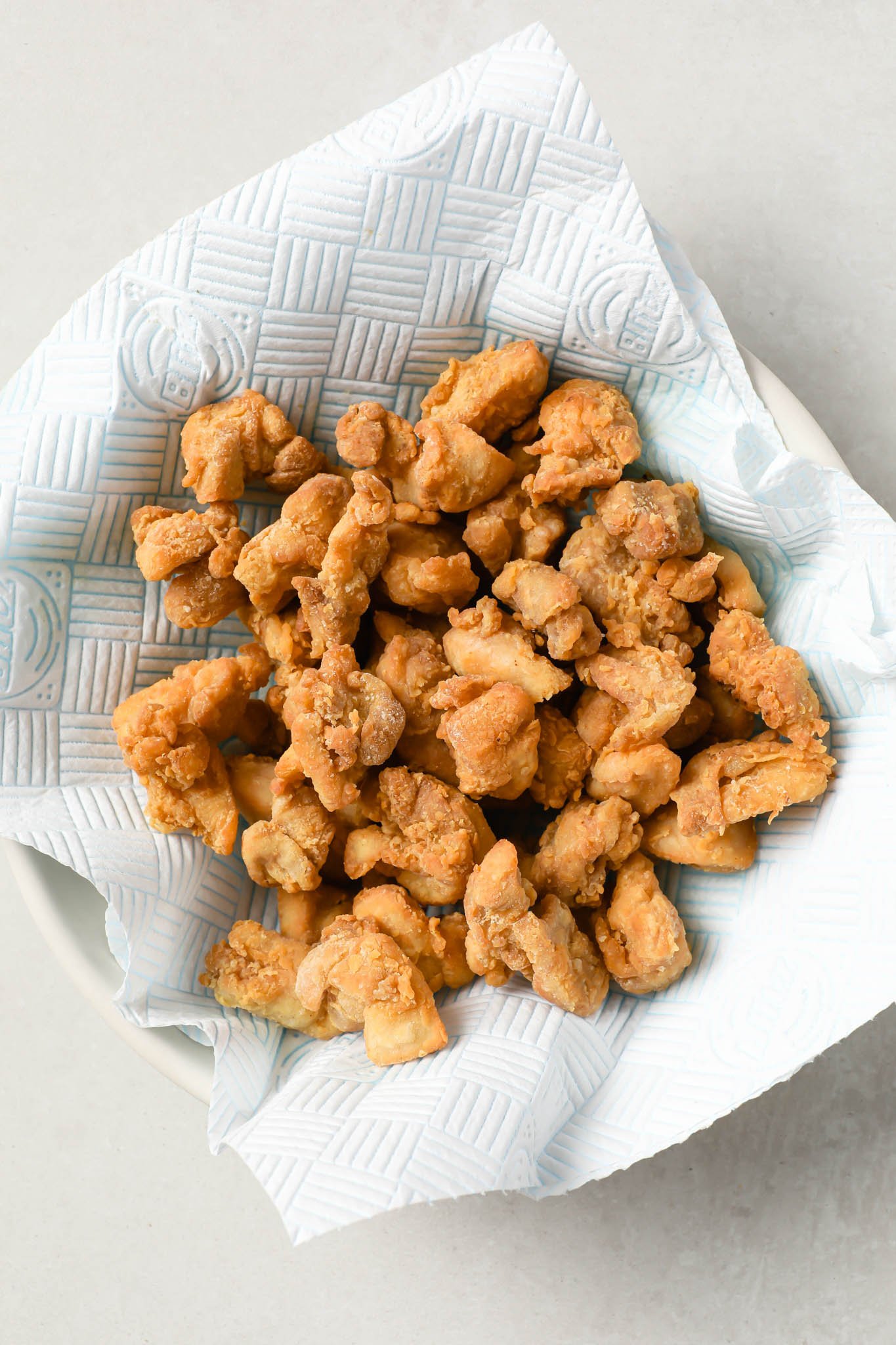
- Fry chicken: Use the least amount of oil you can manage, just enough so that the chicken doesn’t stick to the bottom. This makes it a mess-free, splatter-free process. Once the chicken is golden and crispy, use a slotted spoon to remove and drain it on paper towels.
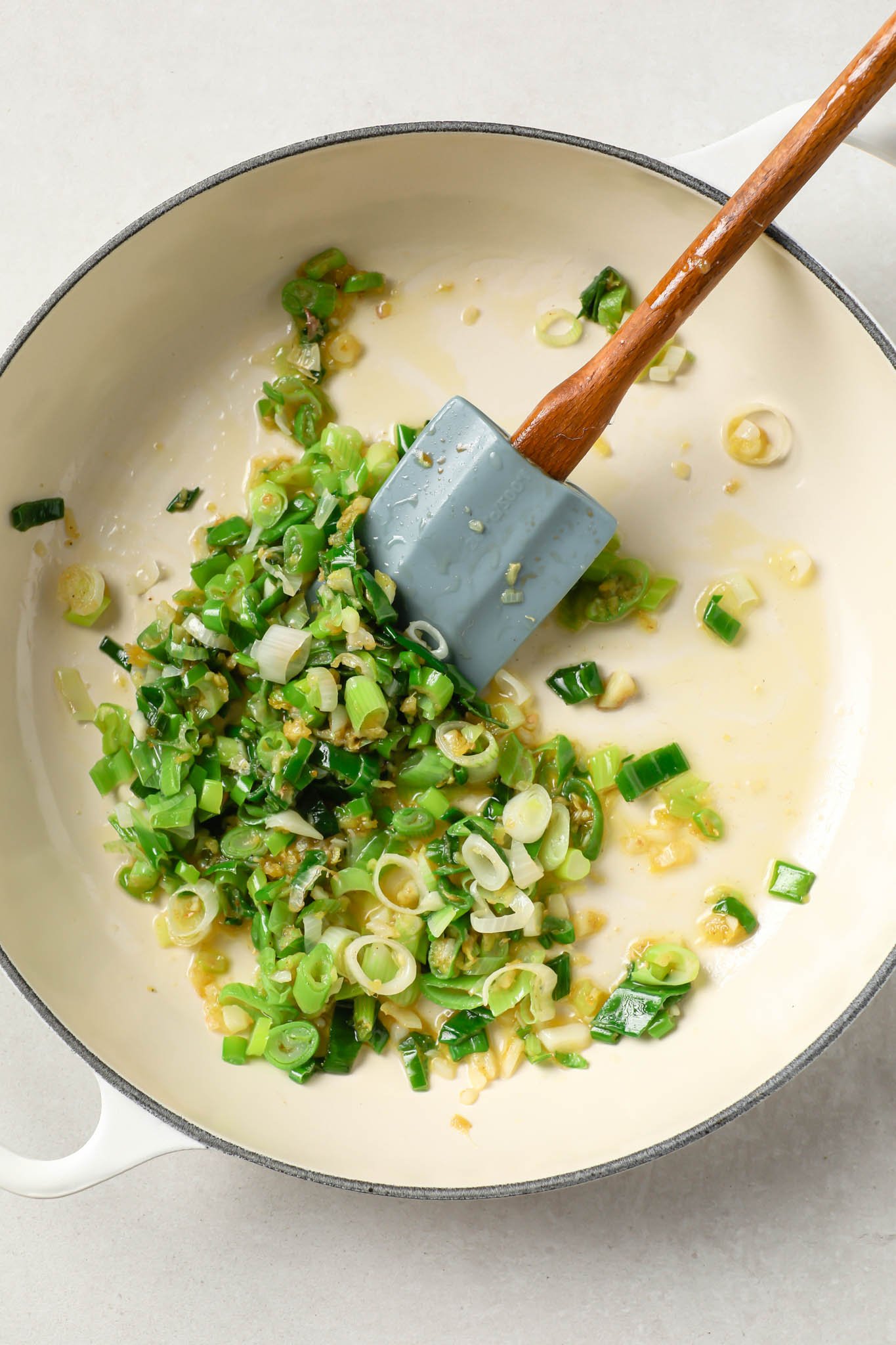
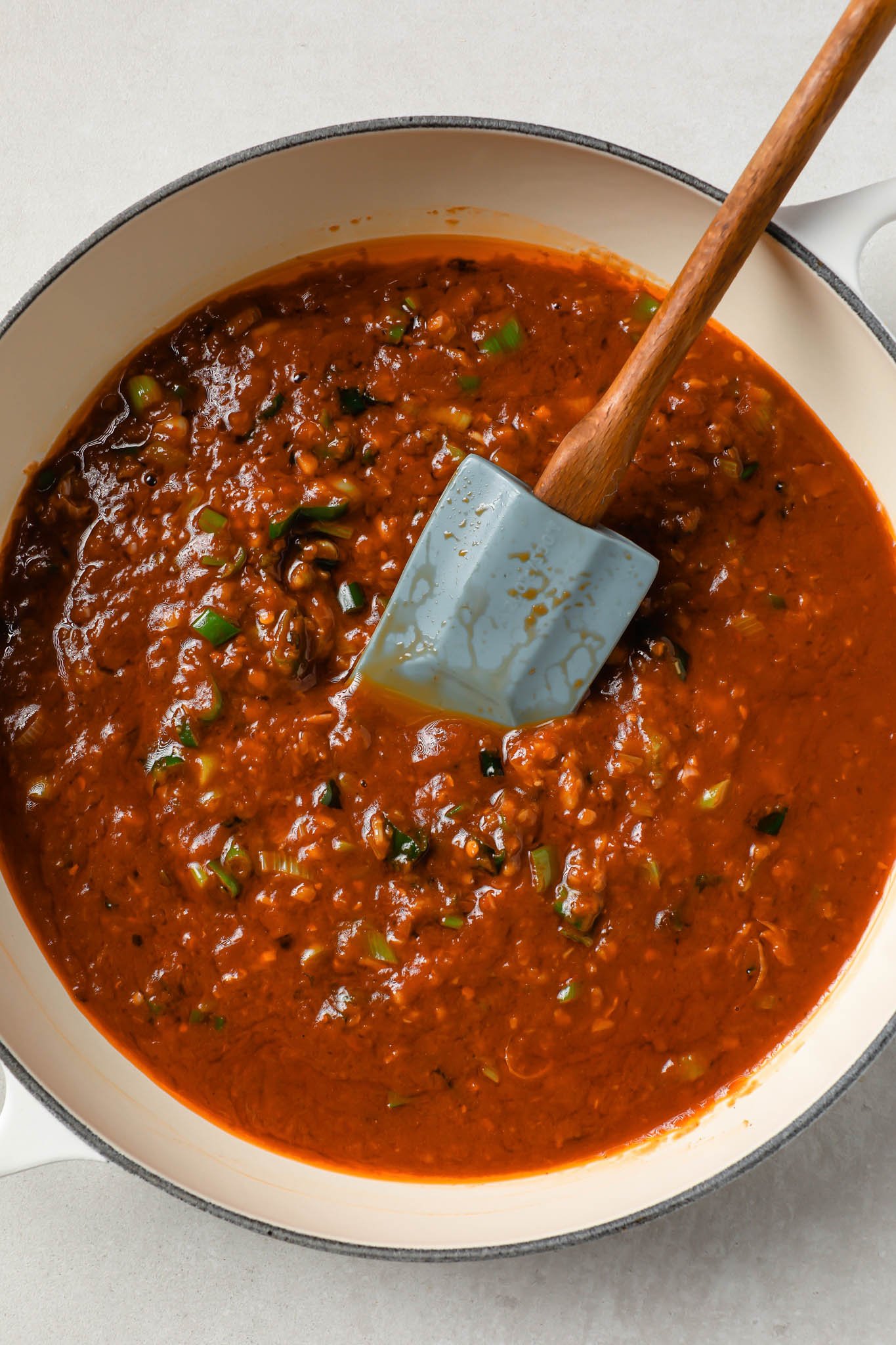
- Stir-fry: Once you’ve cooked the chicken, the stir-fry goes by quickly. Sauté the garlic, ginger, and green onions until the mixture is golden. Take your time here, allowing the garlic and ginger to fully cook but not burn.
- Add sauce: Allow the sauce to come to a simmer so it thickens and cooks out the ingredients.
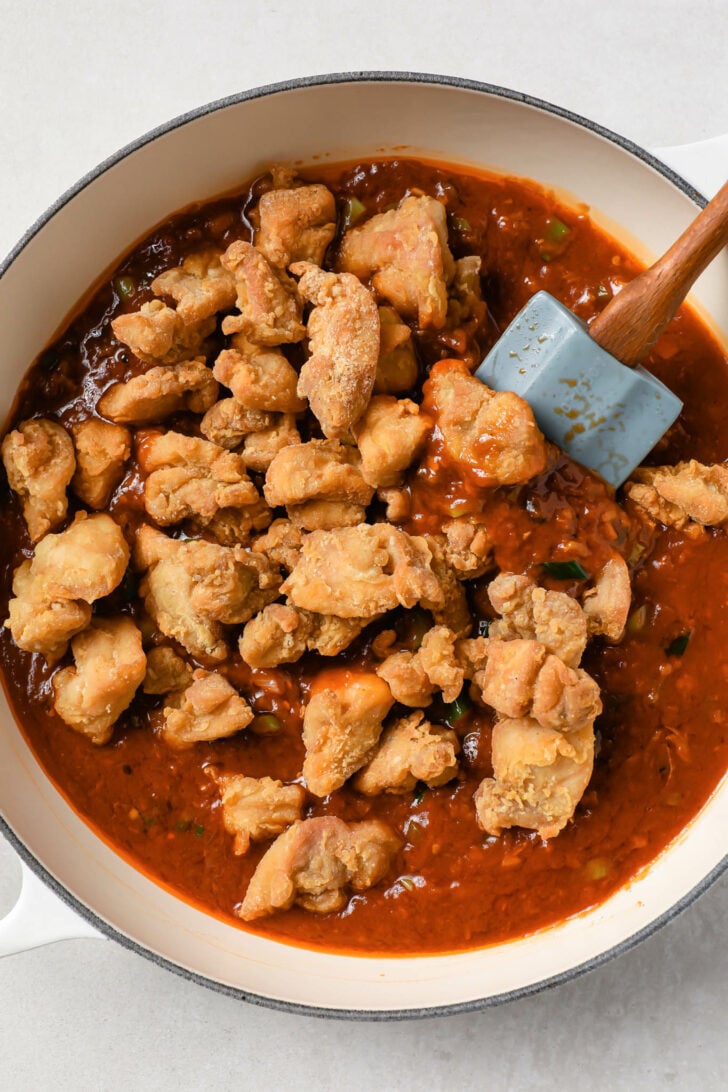
- Add chicken: Once you add the chicken, toss to coat, but do this quickly. It starts to lose its crisp the longer it sits in the sauce.
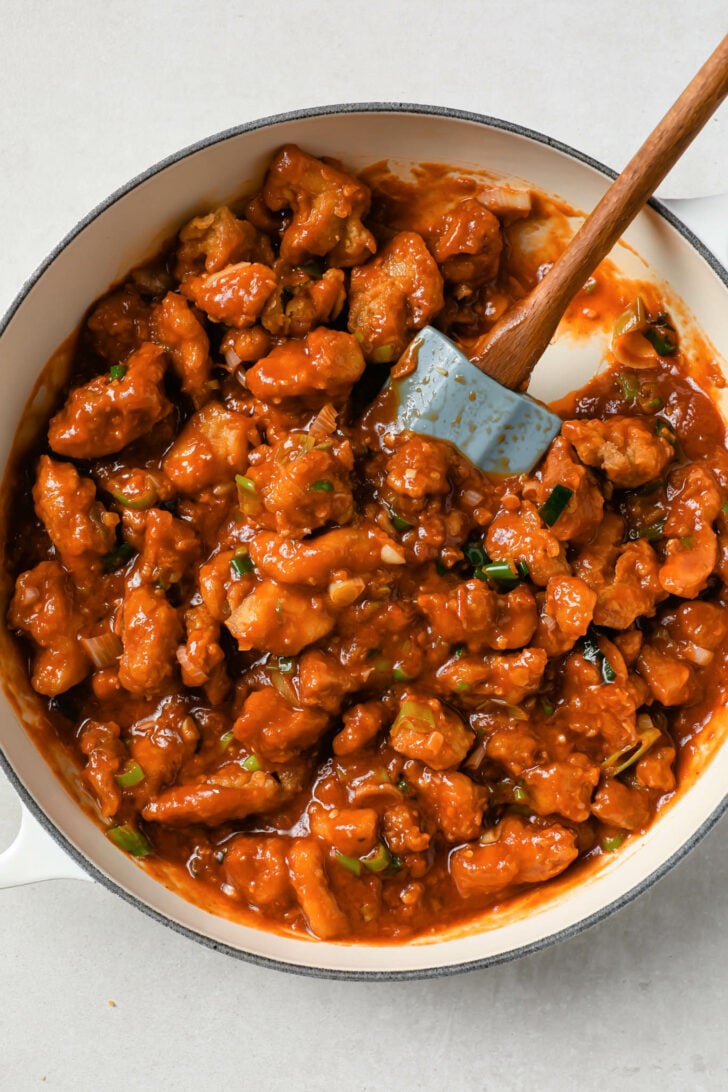
- Garnish with the green parts of the green onion and sesame seeds if you’d like. Serve immediately.
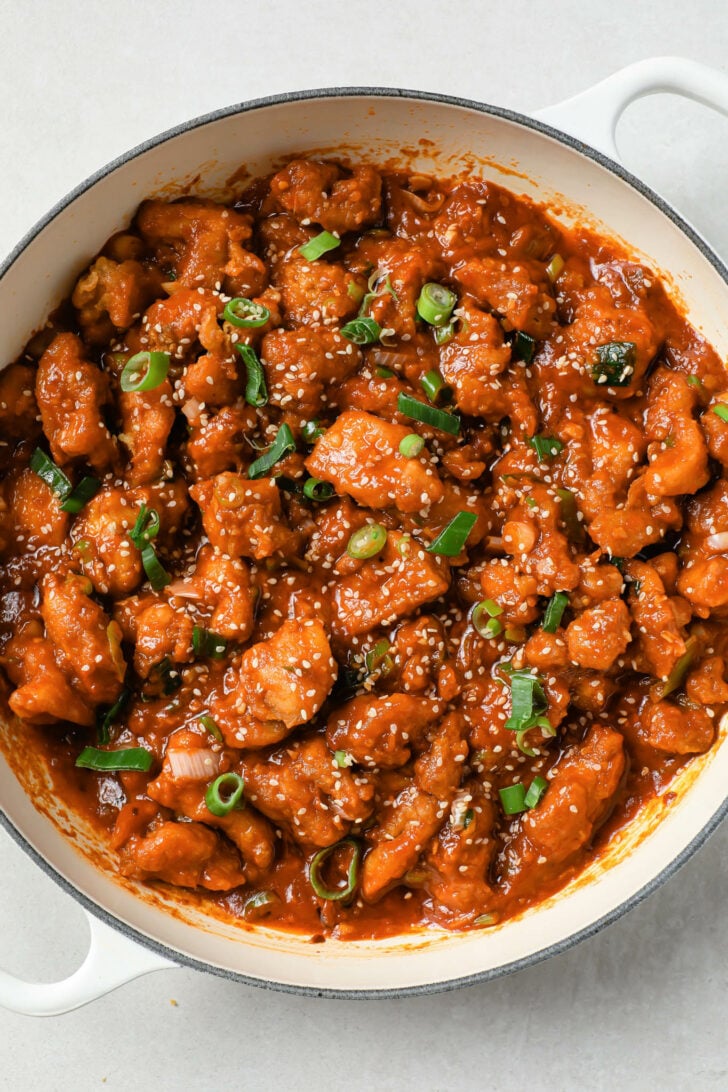
Variations
Pan-fried Option – Less Crispy but No-Deep Frying, No Flour
I suggest the crispy option, and I’d love for you to try it, which is why I’ve included it in the main recipe. Should you still prefer to skip the deep frying or if you’d like to keep it gluten-free, here’s how you’d do it:
Pan-fry Chicken Option
Marinade Ingredients & Instructions
- 1 lb (454g) chicken breast or thighs, cut into 3/4” cubes
- 1 tbsp cornstarch (cornflour)
- 1/2 tsp kosher salt
- 1/4 tsp red chili powder or cayenne
- 1/8 tsp sugar
- Pinch ground white or black pepper
- 1 tbsp neutral oil, such as grapeseed oil
Marinate chicken: Rinse the chicken in cold water & drain. Transfer the chicken to a small bowl and lightly pat it dry. Toss with all ingredients listed under marinade. Set aside.
Prepare sauce as instructed in the recipe.
Pan-fry chicken: Heat the oil in a large, non-stick skillet or wok over medium-high heat. Once hot, add the chicken in a single layer. Cook for 1 minute, until the coating on the bottom is light brown. Then continue tossing and cook for another 1-2 minutes, until the chicken is lightly golden. The exterior of the chicken should no longer be pink. Chicken thighs will take slightly longer than breast. Transfer the chicken to a bowl and immediately cover it. Proceed with the remaining recipe.
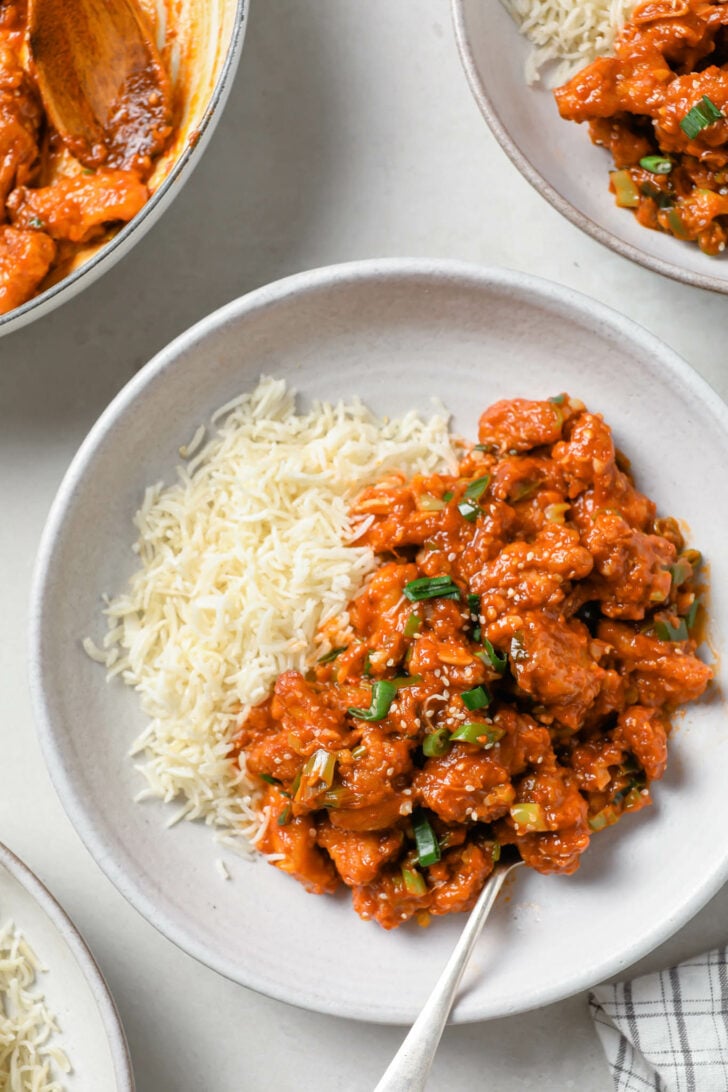
How to Increase Sauce (Gravy)
The two ingredients that contribute to the sauciness of this recipe are the stock and tomato purée/sauce. To increase the amount of gravy, increase the stock to 1 cup and add up to 2 additional tbsp of the tomato purée. Any more than this will likely interfere with the proportions, so you’ll have to do a little taste adjusting.
How and When to Add Bell Peppers
To add bell peppers, use 1/2 of a small green bell pepper (~80g) and 1/2 of a small red bell pepper (~80g) and cube them into 1″ squares.
Add them in along with the green chili pepper. With the heat on high, stir-fry them for 1-2 minutes, or more to your liking. Then add the sauce and proceed with the remaining steps.
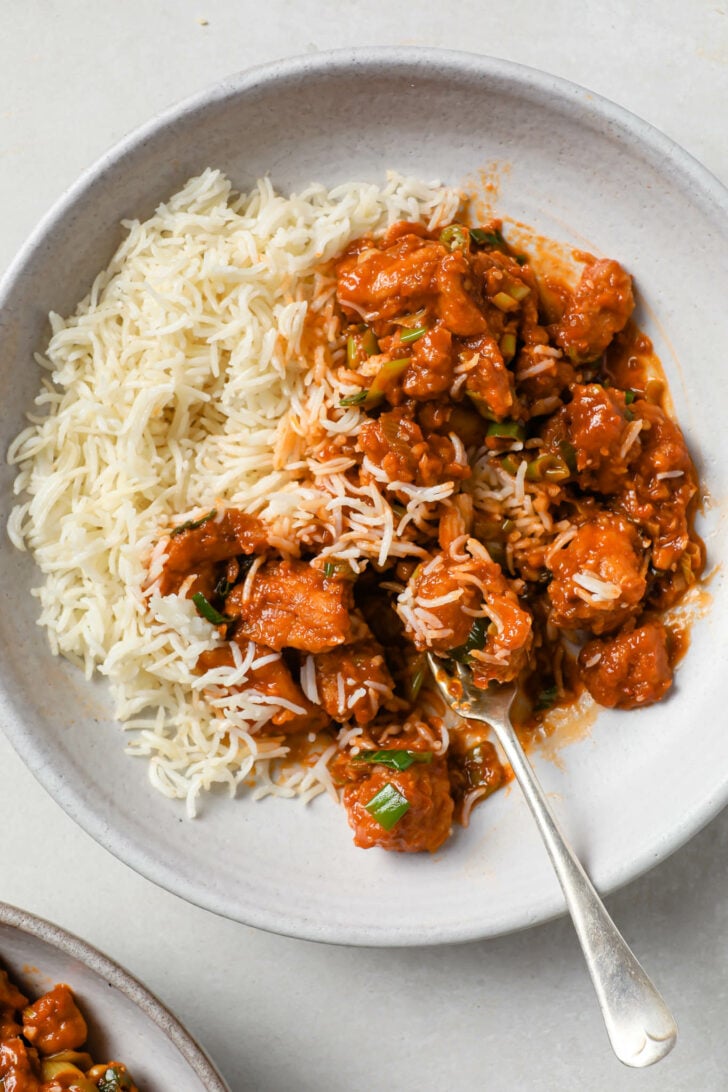
What to Serve with Chicken Manchurian
- Restaurants usually serve the dry version of Chicken Manchurian as an appetizer. As a main dish, you can serve with plain basmati rice, fried rice, or any type of noodles such as Chow Mein.
- For an Indo-Chinese feast, a great menu may involve a soup, a contrasting main dish like Cashew Chicken or Mongolian Beef, rice, Hakka Noodles, and Pakistan Eat’s Desi-Style fried shrimp.
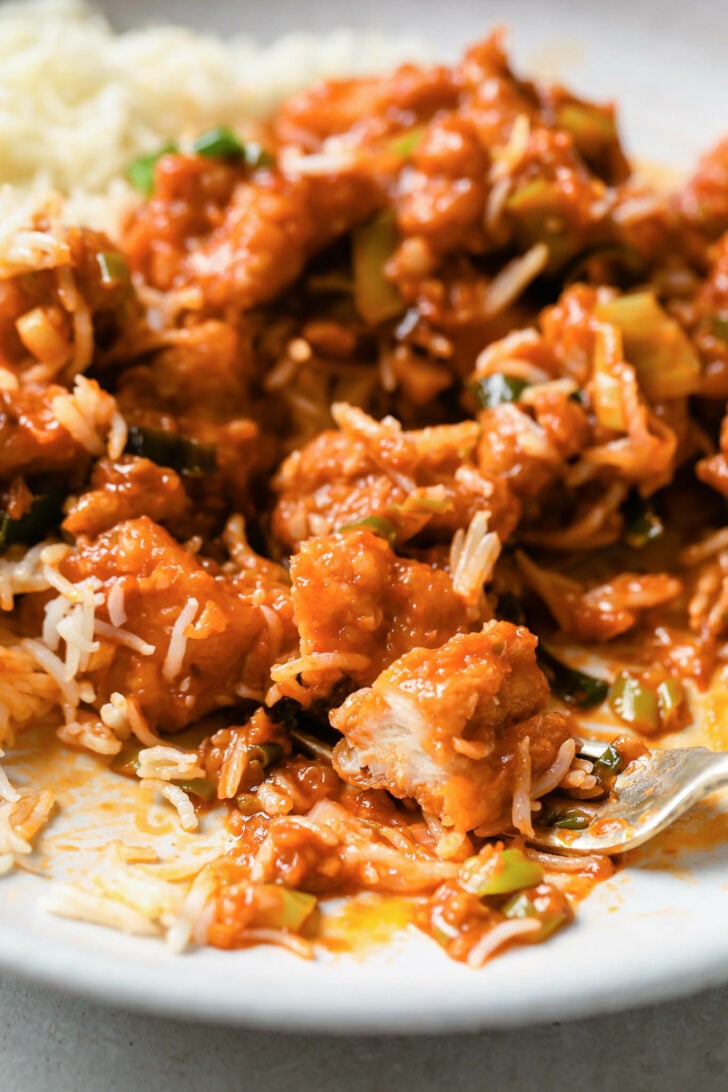
Tried this recipe? If you have a minute, please consider leaving a comment telling me how it was! If you’re on Instagram, please tag me so I can see your creations. I truly love hearing from you. Thank you!
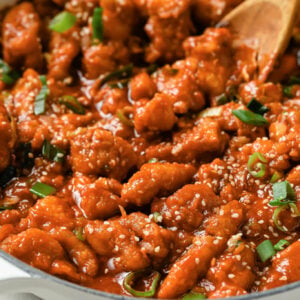
Chicken Manchurian (Crispy with Gravy)
Watch the Video
Ingredients
Chicken Marinade:
- 1 lb (454 g) boneless, skinless chicken thighs (preferable – more juicy) or breast, cut into 3/4” cubes
- 1 egg white, whisked
- 1 tsp soy sauce
- 1 tsp rice vinegar or white vinegar
- 1/4 tsp baking soda
- 1/4 tsp kosher salt
- 3 tbsp cornstarch
Dry Coating:
- 1/3 cup all-purpose flour
- 1/3 cup corn starch
- 3/4 tsp kosher salt
- 1/2 tsp baking powder
- 1/2 tsp red chili powder or cayenne
- 1/4 tsp raw cane sugar
Manchurian Sauce:
- 3/4 cup vegetable stock, or chicken stock
- 1/3 cup tomato purée or tomato sauce, from a can or jar
- 2 tbsp ketchup, I use Hunt's Natural or Heinz Organic
- 2 tbsp chili garlic sauce, preferably South-Asian style, or sub 1 tbsp Huy Fong Chili Garlic Sauce – See Note 1
- 1 1/2 tbsp raw cane sugar, may vary depending on sauces
- 1 tbsp soy sauce
- 3/4 tsp kosher salt
- 1/2 tsp red chili flakes
- 1/8 tsp white pepper or black pepper
- 1 tsp cornstarch
Stir-Fry:
- 2 tbsp neutral oil such as avocado oil, plus more for frying chicken – See Note 2
- 4 green onions (scallions), finely chopped white and light green parts, sliced green parts for garnish
- 5 garlic cloves, finely chopped or minced
- 1- inch piece ginger, finely chopped or minced
- 1 small Thai (bird’s eye) green chili or Serrano pepper, finely chopped
Garnish:
- green parts of green onions
- toasted or untoasted sesame seeds, optional
Equipment
- medium frying pan or heavy-bottomed pot
- wok or large nonstick skillet
Instructions
- Marinate chicken: Rinse the chicken in cold water and drain. Transfer the chicken to a small bowl and lightly pat it dry. Toss with all ingredients listed under Chicken Marinade. Set aside.
- Combine dry coating: In another medium bowl, combine the Dry Coating ingredients and set aside.
- Make sauce: In a small bowl or large measuring cup, whisk together all the ingredients listed under Manchurian Sauce. Set aside.
- Preheat oil: Heat a medium frying pan or heavy-bottomed pot over high heat. Add oil so that it’s at least 1/2”/1.27 cm deep. It should be deep enough so the chicken doesn’t stick to the bottom. Once the oil is hot, adjust heat level as needed to maintain medium-high heat (around 320-350°F/175°C).
- Fry chicken: Transfer half the chicken from its egg white marinade to the dry coating mixture. Toss to coat so that the dry coating adheres well. One at a time, lift the chicken, dust off the excess coating, and gently place the into the hot oil. Fry, turning occasionally, until golden and crispy, about 4 minutes. Remove with a slotted spoon and transfer to a paper-towel lined plate. Repeat with the remaining chicken.
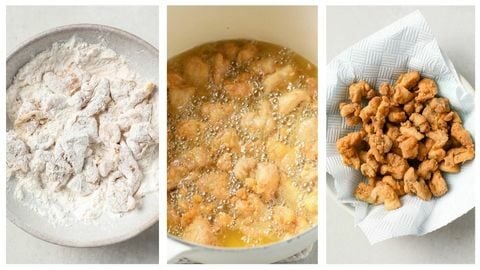
- Stir-fry: Heat oil in a wok or large nonstick skillet over medium-high heat. Add the white and light green parts of the green onion, garlic, and ginger. Sauté for 1 minute. Then add the green chili pepper and stir fry for another 30 seconds, until the garlic and ginger are golden and beginning to brown. Stir in the sauce and allow to come to a simmer for about 2 minutes.
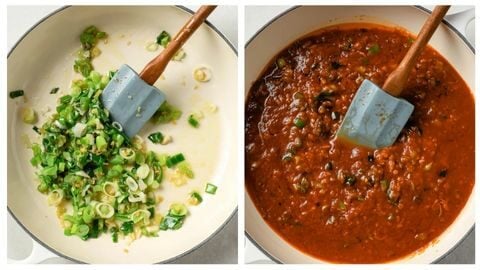
- Toss: Add the chicken back to the wok and toss just until coated (quickly so not to lose the crisp!). Turn off the heat and garnish with green parts of the green onion and sesame seeds, if using. Serve immediately with white rice, fried rice, noodles, or by itself.
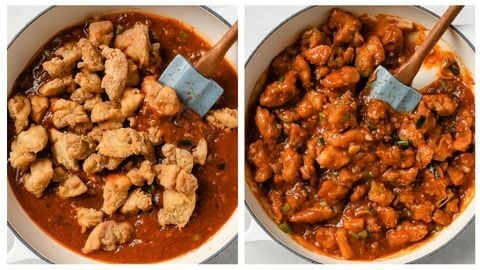


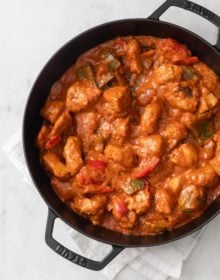
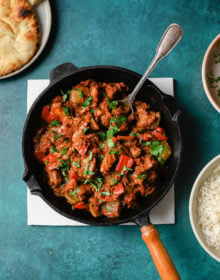


20 Comments on “Chicken Manchurian (Crispy with Gravy)”
I’m excited to try this recipe! Could I batch prep this by frying the chicken, then freezing it in portions? If so, would you recommend warming the chicken in the oven before finishing the recipe to get the crispiness back? Thanks!
I’ve done this recipe once before and it was delicious – so thank you for sharing! Do you have any tips on preparing it in advance?
Can I use crushed tomato in place of the tomato puree? Are they the same thing?
Yes, that would make a great sub. A pureed fresh tomato seems the same as crushed.
Loved this recipe. Everyone loved it – even my picky children. Your steps and pictures were so helpful! JAK!
So glad to hear that, Sadiya! Thank you for sharing with me! 🙂
I made this tonight it was absolutely delish ; thankyou for sharing your recipes
Thanks, Alli!
I’m so excited by this recipe, it was FANTASTIC!!!
I did not believe the chicken would be crunchy….but it was and SO tasty, definitely worth frying.
Looking forward to trying more of your delicious recipes.
Best wishes from London, UK.
I’m so glad to hear that, Claire! Yes, the crunch is definitely worth it! 🙂 Thank you for sharing.
Hi, for the stock can I use knorr’s Yakhni in a cup?
Hmm I haven’t tried this myself but I think you could if you’d like. Just be sure to reduce the salt as you see fit because I know those can be pretty salty.
Is there a recipe for the stock that you make for this?
Hi Areej, I use good-quality store-bought vegetable stock.
❤️ Desi Chinese.
I added green and red bell pepper as suggested in the text, which reminded me of Shashlik (another of my faves from the blog!)
How would you say this Manchurian compares to Shashlik?
Thanks for another great recipe, Izzah!
Glad you liked it, Talha. Thank you for sharing! Did you do the frying method? That’s what really makes it different than Shashlik.
I deep-fried the chicken pieces since I had peanut oil leftover from the previous day, when I prepared General Tso’s with the breast of a wild turkey that I recently shot. I do think that the dredging and deep-frying add some extra effort, which make me lean toward shashlik because of the easier preparation.
Question for you: Your Manchurian recipe calls for using egg whites whereas the General Tso’s recipe I followed recently from a different blog called for egg yolks in the marinade. When do you want to use whites vs. yolk? What difference do they impart?
If you have the opportunity, please make some General Tso’s using this recipe; I would love to hear your thoughts on it:
https://honest-food.net/general-tsos-recipe-pheasant/
The recipe calls for pheasant (it’s a hunting-based blog) but you could use chicken breast.
Oh okay, I see. So I’ve tried with both egg whites and whole egg and with the egg you can taste a little ‘eggy-ness’. That’s why I only use egg white. This is a very interesting recipe. I’ll definitely remember it next time I try General Tso’s. Thanks for sharing Talha!!
Delish!For the tomato puree, I used passata since I had left overs. I also used the National bottle for chili garlic sauce and keeping the recipe as is , with the exception of using 2 TBSP of raw cane sugar (Manchurian sauce) instead of 3. It was tangy, sweet, spicy….. loved it! Thank you for a wonderful recipe that I will be using in my roster,
Yay for the first review! So nice to hear that. You must have doubled for 3 tbsp sugar? Thanks so much for sharing!